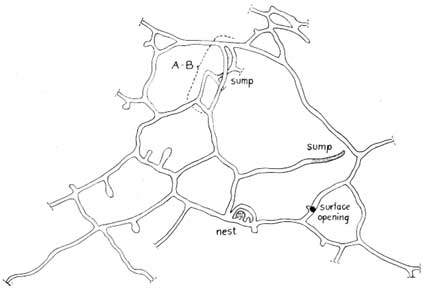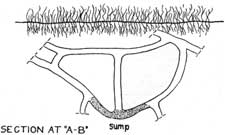|
Animal Life in the Yosemite
|

|
|
THE MAMMALS CALIFORNIA MEADOW MICE. Microtus californicus (Peale) 10 Field characters.—Body size between that of House Mouse and House Rat; tail short, less than one-half head and body; pelage long, soft, and dense; ears short, nearly buried in the fur. (For measurements see footnote.) General coloration above dark brown, middle of back red tinged; under surface blue-gray to whitish. Workings: Runways 1 to 1-1/2 inches wide through grass, connecting with round holes in earth. Occurrence.—Common resident in Lower and Upper Sonoran zones on west slope of Sierra Nevada. Recorded from Snelling (subspecies aestuarinus) eastward to El Portal and Cascades (subspecies mariposae).10 Inhabits grassland.
The California Meadow Mouse is an inhabitant of grassy fields and marsh lands near the rivers and streams of the western part of the Yosemite region. Its range here is restricted to those rather scattered portions of the region which are open and fairly level. The species is common in the flat areas along the eastern margin of the San Joaquin Valley, but in the foothill districts it is for the most part found only in the scattered streamside tracts which man has found to be most suitable for his own purposes. In general appearance and habits the California Meadow Mouse is much like the Yosemite Meadow Mouse which lives in the territory from Yosemite Valley to the crest of the Sierras. It is, however, of somewhat larger size and makes slightly wider runways. As with other meadow mice, the breeding season of this species is long. At Pleasant Valley and near Coulterville, in late May and June of 1915, young were already about in some numbers; and near El Portal in late November and even as late as December 5 (1914), half-grown individuals were trapped. On November 29, an adult female captured at El Portal was found to contain 5 large embryos. This number is probably an average. The food of this mouse consists chiefly of grass, which is freshly cut in lengths of about 1 inch, presumably so that it can be more readily carried, along the runways and burrows. This meadow mouse, like others of its tribe, is subject to decided fluctuations in population from year to year. If one examines for a number of successive years the ground where the animals occur, one will note decided changes in the extent of their operations. In 1915, the population in the meadows adjacent to Bean Creek east of Coulterville seemed to be at a low ebb, for only by vigorous efforts in trapping could we obtain even a few individuals; whereas, as a rule, the capture of meadow mice in numbers is a relatively easy matter. Many of the burrows and runways which we examined in this place were in a state indicating disuse. The holes were frequently covered with cobwebs, and small plant growths had sprung up in the runways. Neither of these conditions is to be noted in runs which are in current use by the mice. In 1920, trapping a short distance to the east of this locality, on Smith Creek, produced a number of the animals. At El Portal, on December 4, 1914, an adult meadow mouse was found with its hair firmly entangled on a twig in a brush pile. It had evidently made frantic efforts to escape, going round and round the twig, but this had only served to bind its hair all the tighter and being thus held the mouse perished, either from exposure or starvation. Meadow mice, particularly those species which inhabit runways, are given to extensive travel during the daytime. The runways are, in many instances, nearly or completely covered by the adjacent grass, and would seem to afford a more complete protection than is available to many of the other small rodents. Nevertheless, meadow mice, more often than other small rodents, fall victims to hawks; and their activity at dusk likewise results in many of them being caught by owls.
On a meadow at the head of Bean Creek east of Coulterville a series of runways and burrows of the Mariposa Meadow Mouse was opened up, studied, and mapped by two of our party on June 8, 1915. (See figs. 17, 18.) The meadow was covered with a dense growth of rush, foxtail grass, blue-eyed grass, soaproot, buttercup, wild celery, and other plants. The fine black humus through which the tunnels were dug was damp and the soil a few inches below the surface of the ground was saturated with water. Some slight depressions in adjacent parts of the meadow still held standing water. The part of the meadow where the tunnels were located was very green; while on nearby higher and rockier parts the grass was already dry and no evidences of meadow mice were to be found. Both surface runways and underground tunnels were found in this colony, but only the tunnel system is shown on the accompanying diagram. Some of the runways led into holes which looked like abandoned gopher holes, a fact which suggested that the meadow mice had possibly made use of tunnels dug earlier by gophers.
An area approximately nine feet square was gone over in detail and the sod lifted off so as to expose the tunnel system. The ground was so soft that for the most part the work could be done with the hands, only a few of the deeper parts requiring the use of a shovel. Some of the tunnels contained evidence of recent occupation by meadow mice in the form of scattered short cuttings of grasses and composites; in a few places there were footprints of the mice in the soft earth on the tunnel floor. A reddish material covered the floor in some of the old galleries, and here the foot prints showed to good advantage. Scattered along the tunnels were the droppings of the mice. Only about half the tunnels which were opened up gave any evidence that they were in use during the current season. One recently built nest of dry grass, and part of an old one, were found in side pockets off two main tunnels. The newer nest cavity had two entrances, serviceable also as avenues of escape in time of danger, and there was also a short accessory loop leading around the nest. In various places there were sump holes (fig. 18) which were dug to a lower level than the tunnels off from which they branched. These undoubtedly served to keep the tunnels drained, as each sump had more or less mud in its bottom. At other places there were slight side pockets or 'turn abouts' just large enough to hold a mouse. Only one hole connecting the surface runways and tunnel systems was found in the area studied. This is an unusual condition as compared with other Microtus runways which we have examined. Only one Microtus, quite a young individual, was obtained at this system of runways, though trapping was continued there for several nights. |
| <<< PREVIOUS | CONTENTS | NEXT >>> |
Animal Life in the Yosemite ©1924, University of California Press Museum of Vertebrate Zoology grinnell/mammals43.htm — 19-Jan-2006 | ||

